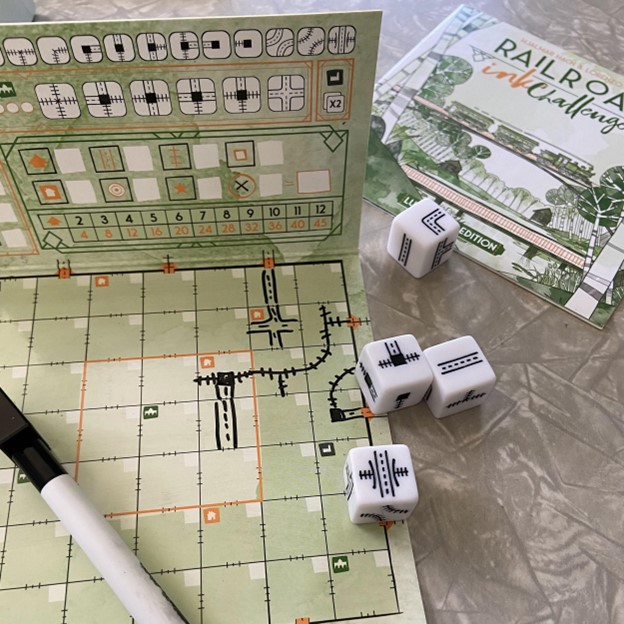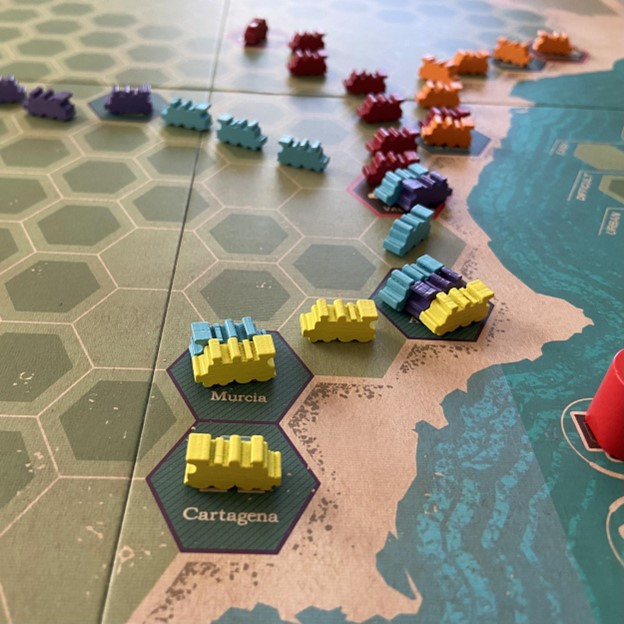Train games have not yet reached their final destination.
Why does that matter, you might ask? Surely, all train games are old and out of fashion and far too complex for the busy, modern gamer? The truth is quite the opposite, Dear Reader. Train games are an historic genre of table top, but they are certainly not a thing of the past! Not only are train games still chugging along, I submit that there is reason to be even more excited about trains’ modern gaming applications. Train games are no longer just stocks and tracks for hours and hours on end. Train games run the gamut of gaming mechanisms and styles. What’s more, they have become infinitely more accessible to the casual gamer than their hefty predecessors like Empire Builder and the 18XX games.

The most obvious example of this new, modern, and simple train game is Ticket to Ride. It has become a staple at contemporary family game nights alongside the likes of Catan and Pandemic. Ticket to Ride is route- and network-building mixed with some light card drafting and contract fulfillment–an ultra-simplified play on traditional train games. But new train games are not confined to “play a card, build a track.” Every major publisher has put out at least one successful train-adjacent game in the last decade or so, and they’re not just iterating on the same game over and over again.
Train as setting, but not mechanic:
Colt Express is an action-queue and hand management game in which players are train robber meeples in the Wild, Wild West engaging in physical altercations with one another while looting a three-dimensional train. The train does not move and not a single inch of track is built. But the train is a fantastic setting for this fun action-programming game, and the 3-D train on which meeples literally jump around stands out as one of the best game environments in all of tabletop.

Route-building, but really weird bits:
String Railway keeps the classic route-building between stations mechanic, but dramatically changes the game elements which physically represent the setting and the routes. This 2009 game seamlessly integrates light strategy with dexterity. String Railway is a route-building game except your track is strings and the play area is the negative space in a loop of string. There are mountain and river obstacles made of (you guessed it) string. String Railway cleverly pulls from the dexterity game genre while still integrating the types of constraints a more traditional gamer would expect. “You can’t build a track if you don’t have the resources to do it” is a familiar constraint, it just so happens that the resource needed to build your track is a physical length of string. The strategy is in how to best utilize your limited number and lengths of strings.
Popular mechanisms with train themes:
Roll-and-writes and their variations (flip-and-write, pen and paper, etc) have recently become more popular, and many of the big hits from the genre have been train-adjacent. The archetypal roll-and-write train game is Railroad Ink in which players draw rail and road networks based on a communal roll of specialized dice. In a similar vein, Metro X and Next Station: London are flip-and-write games that require players to make connections based on communal drafted cards. Due to the lack of actual physical pieces, these games stick to route-building mechanics but can really scratch the itch for satisfying optimization strategy.

Traditional maps, but added mechanics:
Stocks and trains go together really well. Many traditional-style train games incorporate some form of investment mechanic in which the values and costs of certain components can change based on the conditions of the game. Markets and auctions, as well as stock-holding are all popular mechanical pairings with train theming. Iberian Gauge is a basic route-builder-plus-investment but with the added challenge of cooperative action. In Iberian Gauge, the third in a trio of train games from much-beloved designer Amabel Holland, the trains can’t get where they’re going without the combined finances of several players. Each player must also diversify her stock interests in order to make money for future investments. Decisions about where the train is headed must be collaborative between share-holders, lest they risk running the train out of track and tanking its value.

So what has changed, fundamentally, to make the Train Game of the Modern Age? As illustrated above, playing on mechanics beyond a board with a map and cards. The malleable nature of trains as a thematic device has taken the genre far beyond the route and contract. Publishers are embracing trains as a part of modern aesthetic because trains are still beloved by many.
Nobody hates a train, and while I’m not sure the romantic notion of riding a train through the European countryside on a gray, misty day while wearing tartan and a cozy jacket will ever be adequately captured by a board game, one cannot deny that there is something about the whimsy of trains which draws designers and players back to trains time and time again. So take this as your invitation, dear reader, to say “yes” the next time the train gamer in your group wants to try yet another train game. The new train is here for modern gamers of all types.
Missing a really good train game in this years release of The Transcontinental.
Thanks for your comment, John! I used to think I had a good handle on most train games out there and then I discovered how wrong I was and that, in part, motivated me to write this piece. Thanks for the heads up about another one to try! Anyone else have a train game they love?
[…] love of track-laying, pickup-and-deliver games is well documented. And anyone who has ever gamed with me knows I love a good worker placement. Truly, it is only […]